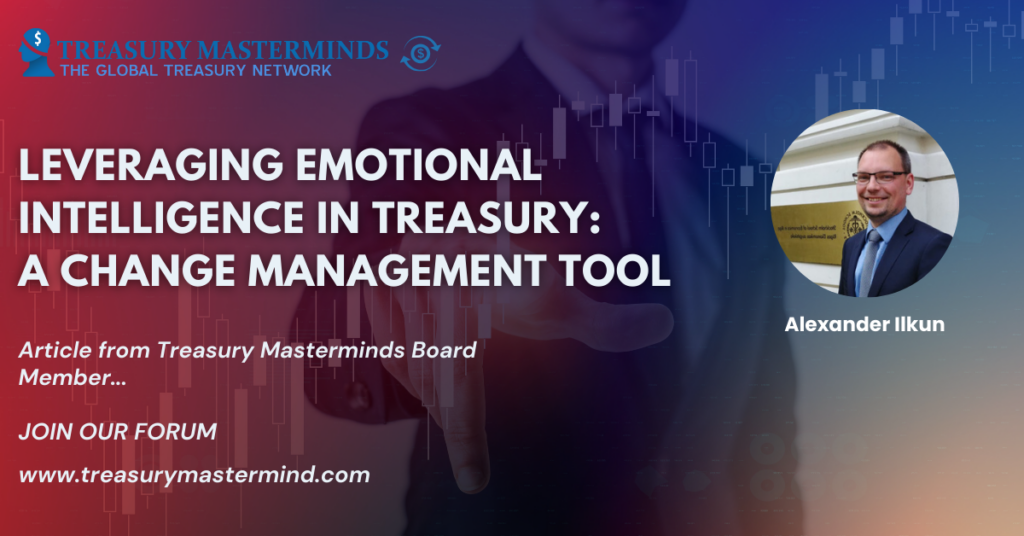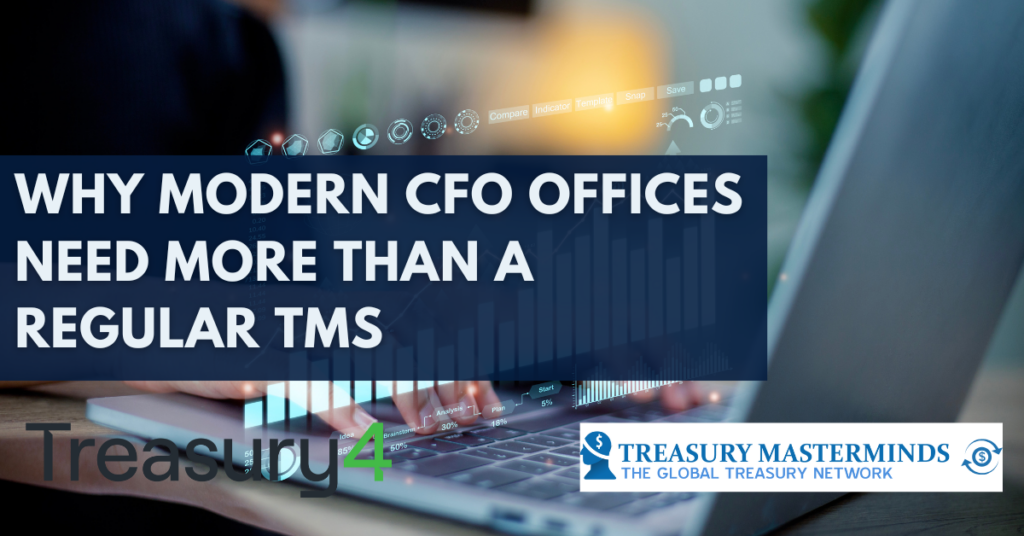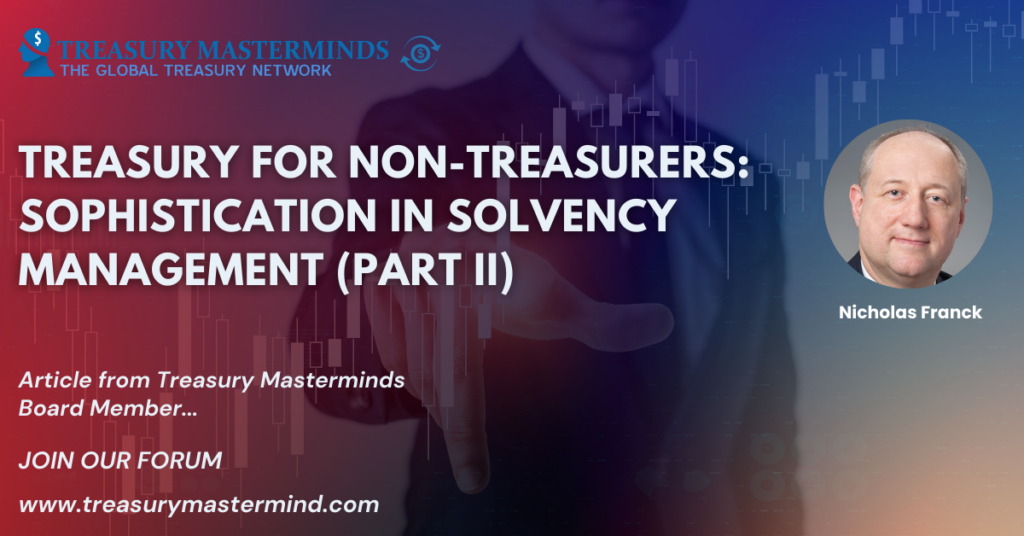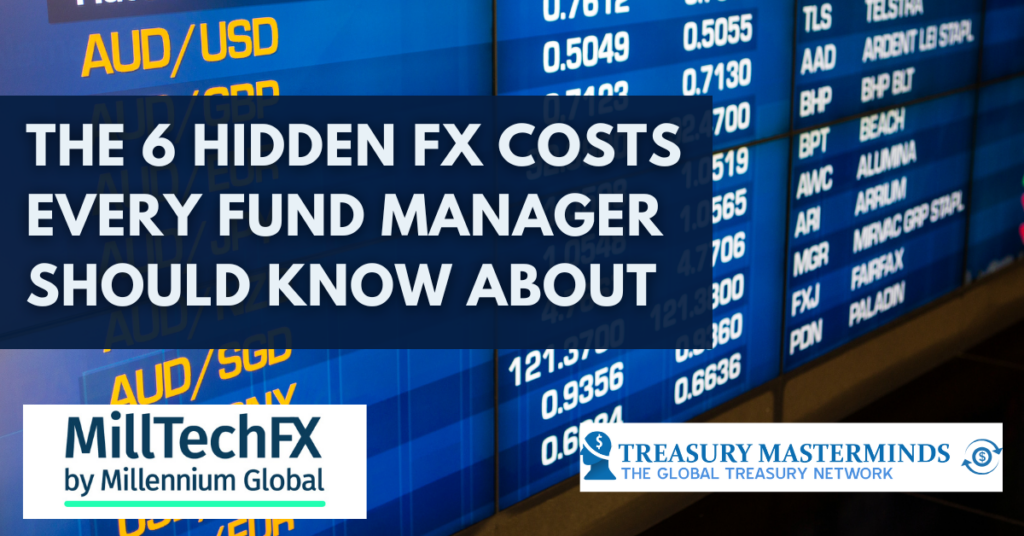
Leveraging Emotional Intelligence in Treasury: A Change Management Tool
In today’s world, Emotional Intelligence (EI) skills often seem undervalued, especially as we observe leaders as people exhibiting narcissistic and populist behaviors. Empathy appears diminished amid ongoing global conflicts lacking resolution. Even in business, where pragmatism and long-term focus are paramount, the lines between politics and corporate interests blur, challenging the role of EI. Despite these trends, EI remains crucial for individual success and societal well-being. A deeper understanding of our own and others’ emotions, coupled with actions rooted in this awareness and positive intent, can lead to a more harmonious world. Imagine a Treasury leader – let’s call him John – who is self-focused on his own success, to the detriment of those around him. He views each interaction as a zero-sum game. Would others be willing to collaborate with such a person on labor-intensive tasks, where the Treasury function often plays the role of project manager? Would interaction with such a person help the Corporate Controller – let’s say Clare – overcome her natural resistance to, for instance, the implementation of a Treasury Management System (TMS) that might delay the rollout of a new ERP system? If Clare knows that John typically acts out of self-interest, will she trust him enough to focus on the company’s overall benefits? Will she be open to hearing why the ERP implementation, which directly benefits her function and several others, should be delayed to accommodate the TMS, regardless of how justified the reasons may be? Research shows that EI skills have a significant impact on the success of leaders: These findings hold particular relevance for Treasury leaders, who must operate and lead change in an increasingly uncertain environment. As Treasury professionals, we are entrusted with safeguarding cash and managing financial risks. To do this effectively, we must not only understand and manage our own emotions but also connect with and work collaboratively with others. What is Emotional Intelligence and why are these soft skills so hard? Let’s start with a definition of what Emotional Intelligence (EI) is. As defined by psychologist Daniel Goleman, it encompasses the ability to recognize, understand, and manage our own emotions, as well as the capacity to recognize, understand, and influence the emotions of others. Goleman’s model outlines four key components: These components collectively contribute to effective leadership and interpersonal relationships, highlighting the importance of EI in both personal and professional contexts. These skills fall into the category we typically call “soft skills,” but contrary to their name, they often prove quite challenging to develop. The good news is that these skills are not set in stone. While some individuals may have a better starting point in some areas – or, for a lucky few, most areas – these skills can be cultivated with focus and determination, regardless of one’s background, IQ, circumstances, or other external factors. We have the power to influence and strengthen these skills through intentional practice and effort. First, let’s explore some practical applications of these skills in Treasury, particularly in managing change. Then, we’ll shift focus to how one can assess and improve these skills individually and within Treasury teams. Practical application of EI in Treasury Change Management There are several ways a Treasury leader can leverage emotional intelligence to enhance both their own and their team’s performance. I deliberately avoid the term “manager,” as leadership or influence can be exercised regardless of one’s position within the team or company hierarchy. First, a leader with highly developed emotional intelligence skills fosters a culture of open communication and trust among team members and stakeholders. Such a culture is crucial for the success of any change management initiative, as it ensures that individuals feel heard and valued, creating a solid foundation for collaboration. Emotional self-awareness and self-control enable such a leader to discuss upcoming projects openly, welcoming diverse suggestions and ideas. They can process all types of feedback constructively, recognizing when emotions might trigger a defensive reaction. By managing these responses, the leader ensures feedback is fully considered, ultimately benefiting the project as a whole. Second, emotional intelligence is instrumental in generating buy-in from stakeholders who will be involved in or impacted by planned changes. Organizational awareness allows a skilled leader to assess group dynamics, identify key influencers, and understand their interests. This awareness enables the leader to communicate the project’s importance effectively, emphasizing its benefits not just for the organization but also for individual teams. By addressing the interests of key stakeholders, a leader can significantly boost alignment and commitment. Finally, such a leader inspires and motivates project team members as they navigate the challenges of change. Empathy helps the leader recognize and address the anxieties that naturally arise during transitions, fostering a sense of reassurance. Additionally, skills like a positive outlook and adaptability empower the leader to provide a compelling vision—a “guiding star” that the team can rally around. These qualities also help the leader anticipate and overcome obstacles, ensuring the team remains resilient and focused on achieving their goals. EI skills are not static and can be trained One of the most important things to remember about Emotional Intelligence skills is that they are not static. While we all have different starting points in life, with varying levels of development in EI skills, these skills can be improved over time. Importantly, those with already strong EI often recognize the need to continuously evolve, understanding that there is always room for improvement. To this end, the Emotional and Social Competency Inventory (ESCI), developed by Korn Ferry Hay Group and Daniel Goleman, is an excellent tool for measuring EI skills. It is a 360-degree feedback tool that allows individuals to measure 12 EI competencies, not only by completing a behavior-based self-assessment but also by seeking feedback from those they work closely with—managers, peers, and subordinates. This provides an overall view of one’s EI skills, highlighting areas that may require focused development at a particular time. This test is widely used by corporations and can be customized to align with a company’s values by…

Beyond the Basics: Why Modern CFO Offices Need More Than a Regular TMS
This article is written by Treasury4 The role of the chief financial officer (CFO) has evolved dramatically in recent years. While the CFO’s primary responsibilities still include accounting, financial planning, forecasting, and compliance, these duties look different than they did just a few years ago—thanks to the rapidly evolving technological landscape. Now, CFOs must be able to use data-based insights to drive strategic decision-making. They must stay on top of the changing (and more complex) regulatory environment. And they must implement more dynamic financial planning and risk management to adapt to various economic scenarios. Put simply, the CFO’s job is more complicated than ever before. While traditional treasury management systems (TMS) were adequate for CFOs of the past, today’s CFO needs more comprehensive, agile solutions to keep up with the demands of modern finance. In this article, we’ll explore how next-generation TMSs can help support today’s CFO. But first, let’s take a quick look at how traditional TMSs are holding CFOs back… Limitations of Traditional TMSs Traditional TMSs served their purpose well for many years, but they come with significant limitations that hinder the effectiveness of the modern CFO’s office. Here are some of the primary ways they fall short: The Modern CFO’s Office: New Demands, New Solutions To address these challenges, modern CFO offices are turning to next-generation financial management platforms, which offer a range of advanced features and capabilities. These solutions include: Key Features to Look for in Modern TMSs So, what should you look for when shopping for a next-gen TMS? Here are the must-have features: Also Read Join our Treasury Community Treasury Masterminds is a community of professionals working in treasury management or those interested in learning more about various topics related to treasury management, including cash management, foreign exchange management, and payments. To register and connect with Treasury professionals, click [HERE] or fill out the form below. Notice: JavaScript is required for this content.

Treasury for Non-Treasurers: Sophistication in Solvency Management (Part II-Strategic Function)
Welcome back. In the first part of this article, we explored solvency management within operational treasuries. As a quick reminder, solvency management—keeping an organisation solvent for as long as possible—is a treasury’s primary duty. In this second part, we’ll focus on strategic solvency management, the level most valuable and of interest to non-treasurers. To stay consistent, please imagine once again that you are a key decision-maker at Acme Manufacturing Corporation, a company with a multi-billion-dollar turnover, aiming to establish a value-adding treasury to keep the company solvent through changing business circumstances and as profitable as possible. You’ve already assessed the operational treasury options: A control-oriented treasury might be suitable if your organisation’s context allows only minimal change for now or has a limited openness to delegated financial management. But, for now, let’s assume that conditions favour a more strategic approach. Suppose management and key stakeholders are ready for change and willing to invest in a treasury that not only ensures solvency in a crisis but also generates profit under regular circumstances—much like Amazon Web Services does for Amazon in IT. With support for innovation in place, you decide it’s time to learn more about strategic treasuries and, most of all, about strategic solvency management. Strategic solvency management: Financing optimisation and value-chain financing From the last article: “The six levels of solvency management sophistication are: The strategic levels are “Financing Optimisation” and “Value-Chain Financing”. These two levels are similar and related. Both have reached levels where the organisation can be confident the company will not become insolvent during ordinary and, as far as possible, in extraordinary times. Both prove their worth daily by showing management that their capabilities – those needed to handle a crisis – are strong enough that they produce a profit during other times. The difference between the two is in focus: ‘Financing Optimisation’ level treasuries provide value-adding financing (and associated investments) to the organisation’s internal functions, such as sales and procurement, so that they can deliver the organisation’s products and funding in one integrated offering to customers and suppliers (Cisco Capital, Tesla Financing). ‘Value-chain financing’ level treasuries do so directly with external counterparties, for example, equipment financing functions where the financing arm often finances equipment from competitors and other manufacturers in addition to their own (Caterpillar Financial Services, Siemens Financial Services). A ‘value-chain financing’ treasury is a separate line of business that includes a ‘financing-optimisation’ level treasury within it and has, in addition, an externally-facing salesforce and other departments needed by the function to operate standalone. Benefits of strategic solvency management The benefits of a strategic approach to solvency management are far beyond what operational treasuries offer. Beneficiaries Many non-treasury departments can become more effective by hiring skilled treasury professionals and putting them in a well-structured, controlled treasury environment. These include: And potentially more. All at the same time. For these levels of treasury function, it doesn’t matter which internal departments or external parties need what. If it’s related to cash flows and their associated implications, it’s what strategic treasuries know about and manage. It’s their bread and butter. Of course, these treasury functions must do more than receive requests passively and process them mindlessly. As strategic partners, they must understand the details of these requests and provide their customers with insights into potential consequences such as unforeseen costs, uncovered risks and missed opportunities. Benefits A strategic solvency-focused treasury provides departments with the following advantages: In other words, the ability to tailor cashflows associated with offerings to whatever the client counterparties want. Examples of flexibility in action Imagine, for instance, that the sales team wants to offer a client financing to purchase expensive machinery. To compete effectively, they might want to keep the price unchanged while the client considers the offer. They might also like to provide flexible payment schedules or adapt to a custom payment plan asked for by the client. The more options treasury can offer, the more likely sales will win the deal. Another example could be when treasury works alongside procurement to negotiate with suppliers where the relationship is vital, but the purchasing power is on the suppliers’ side. Treasury can support procurement in exploring options with the suppliers, such as paying them in their preferred currencies or including interim stage payments. Treasury can support procurement to maintain and even deepen these strategic business relationships. Of course, sales and procurement could do this without treasury’s help. But they are not financial market experts. The risks of them getting it wrong, creating losses and harming their key relationships would be more likely. Such flexibility is invaluable in dealings with external customers, suppliers, employees, and sometimes even tax authorities. Even though market conditions fluctuate and rates vary constantly, non-treasury functions can give their counterparts whatever financial certainty they desire. Naturally, there’s a cost associated with this flexibility. However, organisations typically charge a smaller uplift for financing that’s directly tied to their core business compared to third parties like banks. Acme Manufacturing can do the same. Associated costs and infrastructure OK, fine, the benefits are substantial – What about the costs? When factoring in cover for absences, staff turnover, handovers, and project needs, the scope and costs of a strategic treasury are substantial. Acme must approach this intricate treasury function’s structuring, implementation, management and ongoing support with great care if it is to succeed. Organisational Structure A sound organisational structure is vital to a strategic treasury’s stability, health and longevity. Non-treasurers need to understand the internal structures of these functions to see if they will be suitable long-term partners for them. Base components Given the complexity and similarity to a bank’s needs, it’s not surprising that successful strategic treasuries adopt organisational structures similar to those in banks. Key roles within a strategic treasury include: Salespeople-Equivalents: These specialists liaise with internal and external clients. Their role is to understand clients’ needs, advocate for their interests within the treasury function, and translate their requirements into words other treasury colleagues understand. Examples: Traders-Equivalents: These market specialists work directly…

Crafting a Compelling LinkedIn Profile
Your professional brand matters, and the pillar of that brand is your LinkedIn profile. Type your name into any search engine and the first result will be your LinkedIn profile. and your professional success. This blog shares 10 dimensions that define the impact, or lack thereof, that your LinkedIn profile plays in communicating your value within and beyond your profession. This graphic says it all: If you are less of a visual person, here are the ten dimensions of LinkedIn profile success with more color: In closing, I want to share a trick I use to keep my LinkedIn profile compelling, look at the profiles of your peers and “borrow” ideas from those profiles that really resonate with you. Here are ten LinkedIn profiles in the treasury arena that have manage to catch my eye: I have gotten some kudos about my LinkedIn profile as well that you can see HERE. Also Read Join our Treasury Community Treasury Masterminds is a community of professionals working in treasury management or those interested in learning more about various topics related to treasury management, including cash management, foreign exchange management, and payments. To register and connect with Treasury professionals, click [HERE] or fill out the form below. Notice: JavaScript is required for this content.

The 6 hidden FX costs every fund manager should know about
This article is a contribution from our content partner, MillTechFX In our newest blog post, we are highlighting some of the costs associated with FX execution and hedging that fund managers should be aware of and rank them in order of transparency. FX Execution Costs Execution costs are often the first thing fund managers will reference when speaking about FX costs. Think of a bank as a currency wholesaler, who will then discount away from their wholesale rate to incorporate a profit margin or ‘spread’ when they quote their clients. The spread will be impacted by various factors including, but not limited to: In theory, this cost should be easier to monitor and manage than all the other costs in this list. However, in practice, and even to this day, many fund managers cannot say explicitly what they are being charged. One of the best ways for a fund manager to understand their current execution costs is by carrying out regular Transaction Cost Analysis (TCA) via an independent specialist. TCA is to FX execution what an audit is to annual accounts – third party analysis ensures that your FX counterparties are not ‘marking their own homework’. Forward points Forward points arise in certain FX risk management products such as forward contracts or FX swaps and are a universal market cost that is largely influenced by the interest rate differential between two currency jurisdictions. Forward points can be negative or positive, and may be to the hedgers’ favour or detriment, depending on which currencies are being bought or sold. Nothing can be done to avoid forward points, but fund managers should understand that the forward curve isn’t always linear. The tenor of a hedge can be altered to take advantage of a non-linear forward curve in certain circumstances such as when the trade expiry date doesn’t need to match a pre-defined exit date. Any spread that is incorporated into a forward rate, or the far-leg of a swap, can be monitored using TCA, in much the same way as other Over The Counter (OTC) FX products. The Cost of Cash Drag If you’re a fund manager who hedges FX risk using products such as swaps, forwards or non-deliverable forwards, then you may have experienced first-hand a hidden cost of hedging that isn’t often spoken about – the cash drag associated with placing margin. When placing a hedge, a bank may request cash collateral (initial margin) to be held as security until the hedge matures and is settled. Further, movements in the FX market may result in more collateral (variation margin) being requested, to cover the new mark-to-market of the hedge. If a funds’ investible capital is held back for initial margin, variation margin, or contingent liquidity to cover potential variation margin requests at short notice, then deployed capital must work even harder to hit the target internal rate of return (IRR). It’s almost impossible to know, with any degree of certainty, where FX markets will move and to forecast total margin requirements throughout the life of a hedge – this means, that on day 1, it’s impossible to forecast how placing margin will impact a funds’ investment returns. For this reason, fund managers tend to seek out uncollateralized hedging facilities with each of their FX counterparties with a view to freeing up investible capital. However, hedging on an uncollateralized basis might introduce additional costs that are built into the exchange rate in the form of a credit valuation adjustment (CVA). Credit Valuation Adjustment (CVA) If a fund manager successfully negotiates uncollateralised hedging facilities with their counterparty banks, they should be mindful of the potential for additional FX charges when hedging. Uncollateralised hedging means that the executing bank is taking additional risk on a client when they hedge. After all, that bank has no security against that hedge and in the event of a client default the bank could potentially face a mark-to-market (MTM) loss. CVA is an adjustment in the FX rate to account for the possibility of default. CVA is not zero when FX hedges are collateralized, but it is heavily negated when compared to uncollateralised hedging. CVA will vary from bank to bank, for different clients and might be influenced by prevailing market conditions. This means when a fund manager is executing a longer-dated trade that induces CVA, they can’t know exactly what their hedging costs will be in advance. Although, generally speaking, as the tenor of a hedge increases, so does the potential mark-to-market loss and, therefore, the CVA charge. In order to maintain FX transparency and cost control, fund managers could explore using shorter trade tenors (e.g. 6-months or less) that don’t incur CVA. Historic Rate Rollovers (HRR) HRRs have been around for a while but get a mixed reception from different global regulators and are not generally considered best practice. The appeal of HRRs for fund managers comes from the fact that in theory there will be no cash movements that might normally arise from rolling FX forwards. Standard practice is for any mark-to-market (MTM) gain or loss to be crystallised at each roll date and for the fund manager to receive or instruct a cashflow accordingly. Instead, with HRRs, the single FX counterparty that holds the current hedge incorporates any potential MTM loss into the new hedge rate and the hedge ‘roll’ is performed ‘off-market’. It’s the FX equivalent of kicking the can down the road. HRRs should be considered more of a lending product than an FX product, because any accrued MTM losses are subject to a lending rate being applied to them before the new, off-market hedge rate is decided. HRRs are not considered best practice for the following reasons:: Fund managers should pay particular attention to the discretionary nature of continued access to HRRs every time a hedge is rolled forward, because it relies entirely on the credit appetite of the FX counterparty. HRRs are at their most valuable to a fund manager when they carry a significant MTM loss in…

Managing Resistance to Change in Treasury: Overcoming Barriers
Change is inevitable in any organization, and corporate treasury departments are no exception. Whether it’s change of management, implementing new technology, restructuring processes, or adapting to regulatory changes, resistance to change can be a significant hurdle. In moments of changes companies need to focus efforts on overcoming barriers to change. Some strategies to effectively manage resistance and ensure a smooth transition are: 1. Communication One of the primary reasons for resistance is a lack of understanding which creates uncertainty within the members of a team and the whole organization. Clear and consistent communication about the reasons for change, and how it will be implemented can help to alleviate fears and uncertainties. Good practices that reduce uncertainties and alleviate fears: Keeping everyone informed and updated shows transparency and build trust in leadership as well as will prevent rumours and speculation due to misinformation. 2. Involve Key Stakeholders Early Engaging key stakeholders early in the process can help build support and reduce resistance. By involving key stakeholders in planning and decision-making, you can leverage their insights and address concerns before they become significant issues. Designing a collaborative approach can help to identify potential resistance point and to develop strategies to address resistance and future stoppers at early stages. 3. Provide Adequate Training and Support Resistance often stems from a fear of the unknown or a lack of confidence in new systems or processes. Providing comprehensive training and ongoing support can help employees feel more comfortable and capable of adapting to change. This can include hands-on training sessions, user manuals, and access to support teams. 4. Address Cultural and Emotional Factors, using Empathy In an ideal world, organizations would embrace change, fostering a mindset that views change as an opportunity for growth and improvement, with employees genuinely seeing it that way. However, the reality is that when changes arise, most people in the organization are in their comfort zones, and resistance to change can be high. Key stakeholders might have significant influence within the organization, causing delays in implementing improvements and creating conflicts due to their fear of change and the personal effort they perceive as negative. Change can be emotionally challenging, especially if it disrupts established routines and relationships. Acknowledging these emotional aspects and providing support, such as counselling or team-building activities, can help ease the transition. Being transparent about the challenges and benefits of change can also help build trust and reduce fear, even when change disrupts established team dynamics and relationships. Empathy is a powerful tool in managing resistance to change. By understanding and addressing the emotional and psychological needs of employees, leaders can foster a more supportive and accepting environment. 5. Celebrate success- quick wins Celebrating success and quick wins is essential in change management. Recognizing and celebrating these achievements helps to build momentum and morale within the team. By highlighting quick wins, we can demonstrate the positive impact of our efforts, encourage continued progress, and foster a culture of continuous improvement. 6. Monitor and Flexibility Change management is an ongoing process. Regularly monitoring the progress of the change initiative and being willing to make adjustments as needed, sometimes things don’t go as planned. Stablishing feedback mechanisms is key to provide you with valuable insights to help you identify how the change is being received and where adjustments may be necessary. In conclusion, managing resistance to change in corporate treasury departments requires a comprehensive and empathetic approach. By focusing on clear communication, involving key stakeholders early, providing adequate training and support, addressing cultural and emotional factors with empathy, celebrating quick wins, and maintaining flexibility, organizations can effectively navigate the challenges of change. These strategies help build trust, reduce fear, and foster a positive attitude towards change, ultimately leading to a more resilient and adaptable treasury department. Embracing these practices ensures that the organization can smoothly transition through changes and continue to thrive in a dynamic environment. Other Articles in this Series Join our Treasury Community Treasury Masterminds is a community of professionals working in treasury management or those interested in learning more about various topics related to treasury management, including cash management, foreign exchange management, and payments. To register and connect with Treasury professionals, click [HERE] or fill out the form below. Notice: JavaScript is required for this content.

The Relationship Manager Role of Modern Treasurers
This article is written by Kantox Are you a strategic business partner inside your organisation? The modern treasurer is moving away from being a mere transactional player and instead is acting as a relationship manager of sorts. In our latest interview with Sean O’Connor (SO), Director of Treasury at MongoDB, he explained why treasurers are taking a more strategic role and how technology is helping. In this blog, we will go over some of the key topics Agustin Mackinlay (AM), host of the CurrencyCast podcast, discussed with him around API automation, pricing with an FX rate for efficient risk management, FX centralisation, and more. Read on to learn more. API Automation AM: Explain the role of API technology in Treasury operations.SO: When it comes to the operational side of the business, such as Treasury, and Finance, and Marketing or Legal, which are usually the “support functions” at tech companies, how businesses decide to invest in technology, I think is very important. Within Treasury, getting the foundation of your bank account structures when you look at your geographies and your individual operations and how you manage that side of the business, is a core move that may set you up for success. I think getting that foundation moving places when you look at a Treasury management system or any of the bulking products that we see, from cash forecasting tools to other analytics, and being able to scale from those, is the right route. So I guess this has been hard but to us, at least in currency management automation, APIs play such an important role in removing some of the most manual and resource-intensive tasks in providing real-time data analytics and allowing businesses to scale their operations. In exposure collection even before that in pricing with an FX rate and in providing traceability, for example, for automating swap execution. Relationship manager role AM: Given all that’s happening nowadays in terms of automation, the role of modern Treasurers is evolving towards a relationships manager, having to deal with so many different stakeholders, the banking partners, the C-suite, the commercial teams… How do you avoid siloed-based approaches and act as a relationship manager in a way? SO: Treasury has really evolved due to being able to leverage off technology from a very ops-driven department, to now where treasurers see themselves more as strategic business advisors, who ultimately liaise with other senior stakeholders throughout the business. So I think having that more holistic approach is really important. And building rapport and ultimately strong relationships with your colleagues and peers, is the fundamental thing. If you stay in a silo and you don’t have the buy-in from other teams and other colleagues, you’re going to hit a brick wall getting your ideas across the line. And ultimately, when implementing a project management system, for example in Treasury, you can’t just go and implement it on your own because then it’s a standalone system. How does it fit into your ecosystem? You need to buy in from your account and your GL teams. If you want to look at ERP integration, if you’re looking at your payment platforms and order switch systems, you know, you’ve got to work with those teams too. So looking at it as an ecosystem with that Treasury is one segment of, I think is really important. And I think it works both ways as well. I think you’ve got to ensure that you’re there to be able to support and advise your colleagues from other areas too. FX centralisation and in-house banking AM: At Xerox, you were involved in an in-house bank project. And one of your tasks was to remove as much exposure as possible. What was your approach to the issue of centralisation of foreign exchange risk management, and centralisation of other functions? Would you favour complete decentralisation, full centralisation, or other setups in between? SO: When you look at a business the size of Xerox and the vast volume of entities that they have within their group structure, with thousands of subsidiaries, there are a lot of intercompany transactions going on. So a lot of FX risk can impact the financial statements. So running a global netting program made sense. If we went to manage entities on an individual level and manage their FX risk, it’d be a truly complex hedging program, and we would have needed another team of people just to run those programs. Ultimately, running a netting system for intercompany, and then allowing the in-house bank to manage the net risk, with the entities that had materiality in their exposure, was the decision there. In terms of the ideal degree of centralisation, we’ve seen both extremes that you mentioned there and probably even many other examples, depending on how businesses have grown. If businesses have grown organically, or they’ve grown through M&A and have absorbed other businesses that have had different ways of doing things. In a decentralised setup, you may have a local business partner or finance business partner who’s wearing many hats from all areas of finance, but won’t necessarily be a specialist in Treasury. So knowing when to transact, and when to trade would be my concern there. Another concern would be that not every subsidiary is created equal, so you won’t have consistent ways of doing things. Having a more centralised Treasury function probably gives you more chance of getting that consistency. But I suppose the downside of that is the local staff tend to have more insight into the cash flows. So when it comes to forecasting, the centralised function is relying on those hopes to be pushing up their local forecasts. Ultimately, I think we have to end up in a world of balance, where headquarters decides the FX policy and they partner with the local Treasury team to execute the policy. But it should be driven from the top because then that’s the only way you can ensure consistency across the organisation. Also Read Join our Treasury Community Treasury Masterminds is a community of professionals working in Treasury Management or those interested in learning more…

Discriminatory Pricing Practices in Corporate FX
This article is a contribution from our content partner, Just The following is a transcription of our CEO, Anders Bakke’s, recent webinar: How to protect your business from overpaying on FX transactions. My name is Anders Nicolai Bakke, I’m a serial entrepreneur who’s been in the capital market for a long time and is now proud to be the CEO of Just Technologies. My team and I founded Just Financial during the acquisition of our first capital technology platform back in 2017. We wanted to start another business to solve treasury related problems for companies dealing in the FX market. In this webinar, we’re going to be covering the following: I hope you enjoy it and hope to be able to answer some of your questions at the end. Understanding the FX market I want to first talk about how over-the-counter financial markets are opaque and often hard to manoeuvre for non-financial institutions, such as private companies. What we’ve found at Just is that, in any market where you don’t have access to high-quality data, you are at a considerable disadvantage compared to those who do. In the FX space, counterparties are the ones who have access to the true market rates and they have found ways to monetise that disparity. This is a systemic problem within the market: companies are losing value during FX trades and that value is instead flowing into the profit pools of the banks. So how did this systemic problem manifest? Well, let’s take a look at the FX market and its discriminatory pricing practices: The FX market is very efficient as long as you’re on ‘the inside.’ Whether you’re on the inside is determined by how sophisticated you are, how many counterparties and data sets you have access to, and the understanding you have of the FX space. If you do have access to the right data and counterparties, then you can do your own price discovery and see if you’re getting a fair deal on your FX trades. If you don’t have access to this information and your FX provider knows this, then you’re probably being taken advantage of. Businesses (especially those who aren’t directly related to FX) usually only have access to the prices they see from around one to three banks. This is an issue because the fewer counterparties and rates you see, the less you have to compare. It doesn’t help that the rate banks show you is not the real market rate — it’s a rate that’s marked up both from the SPOT component and credit component. Because FX contracts are entered bilaterally (either peer-to-peer or principal-to-principal), banks themselves admit that it is easy for them to make a profit. Suggested reading: To understand more about whether your business’s FX rates and margins are fair, take a look at our article. How margins are structured in the FX market Now that we understand the issue at hand, we can look at how margins are structured in the FX market. Let’s say a large European bank wants to acquire $1 million from the interbank market. They would go to another large European bank and conduct the same kind of currency trade that everyone would imagine. The typical fees they’d pay for this acquisition would be somewhere between $2-10 per million. That $10 per million includes: So the bank pays that $10, and then turns around to find that one of their largest clients (say in the top 1% of flow) also wants to buy $1 million. In this case, the bank knows that this powerful company has the ability to ask 10-15 banks for a quote as they’re probably on an auction platform, or they have a Bloomberg terminal. Given the potential competition, the bank knows that it’s in their best interest to win the deal as quickly as possible, so they mark up the trade to just $50 per million. If the client accepts that fee, then during that entire process the bank has made a decent profit: they themselves paid $10 to acquire the currency from one of the other banks, and then went on to sell that amount for $50, therefore giving them $40 to pocket. But what about the other 99% of their clients who aren’t as large or savvy in the FX market? What about the average importer and exporter? What about companies who just need to trade $1 million in a vanilla trading pair rather than hundreds of millions? Unfortunately, these large banks know that the average company does not have access to enough counterparties to properly take part in FX auctions. They can therefore charge these companies whatever margin they wish. After many years of analysis, Just has determined that the average margin that banks give to businesses is between $200 – $20,000 per million. Compared to the average $10 that banks charge between themselves, we find this to be pretty insane! There is so much value-leakage from the corporate space that goes straight to the banks and it is for this key reason that we decided to launch our business. Why FX knowledge is important We’ve been in the market for a while now and what we’ve seen across our 100+ clients is how easy it is to approach banks for a real conversation on margins — as long as those businesses are armed with data. Why is this information important to you as a corporate treasurer or CFO? The solution This is not a piece about selling a product — it’s about exploring a systemic problem within the market. And the solution to this problem is actually quite simple. In order to protect yourself from overpaying, you need market data. In most cases just having access to non-tradable rates from Google or Yahoo Finance is not good enough. You need a systemic approach that allows you to see your historical exposure, volume, and current hedges so that you can build a case from which you can sit down with your bank. For this purpose,…

Building The Network You Need to Own Treasury Career Success
Your professional network is a key pillar of your professional brand and your professional success. Despite all the hype around AI and related technology, soft skills are critical to being a treasury professional no matter where technology takes the treasury profession. There is quite a bit of content around the importance of building a professional network, but seldom, if ever, is actionable advice shared on how to actually do it. This blog will do just that. There are several building blocks that should each be leveraged in building the professional network of any treasury professional: Identifying the people you want in your network within each channel can be done by asking yourself these questions: In terms of how to inspire people to be a part of your professional network: Finally, I want to share several ways to build connections beyond company walls: Stay tuned for the next blog in Managing Your Professional Brand in Treasury series! Also Read Join our Treasury Community Treasury Masterminds is a community of professionals working in treasury management or those interested in learning more about various topics related to treasury management, including cash management, foreign exchange management, and payments. To register and connect with Treasury professionals, click [HERE] or fill out the form below. Notice: JavaScript is required for this content.